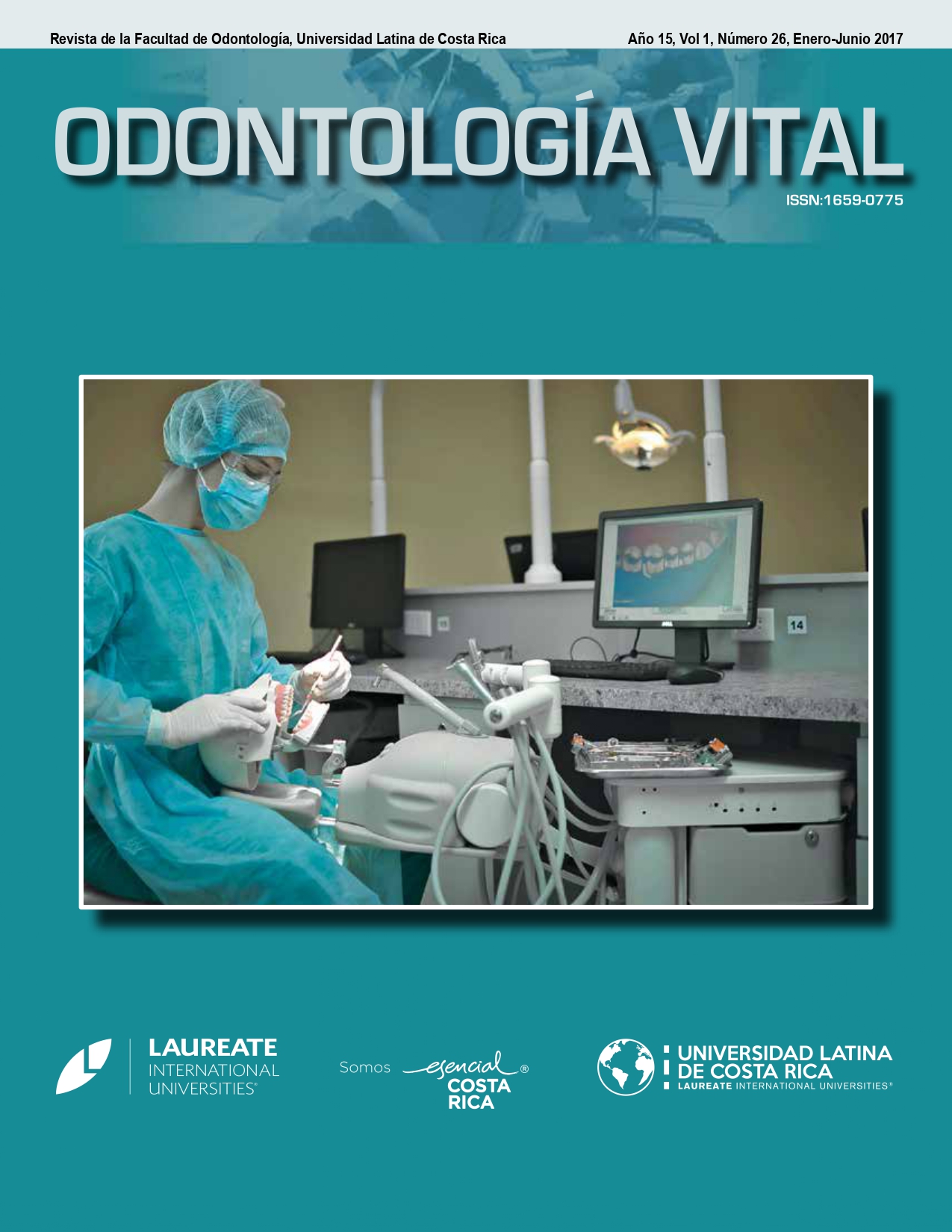Study of malar, maxilla and mandible fractures at hospital discharges from 2010 to 2015 in the Caja Costarricense de Seguro Social
DOI:
https://doi.org/10.59334/ROV.v1i26.224Keywords:
Maxillofacial, facial fractures, malar, maxillary, mandibular, facial trauma, prevalenceAbstract
The objective of this research is to determine the prevalence of malar, maxillary and mandibular fractures in patients of the Social Security Hospitals during the years 2010 to 2015 analyzing the relationship between age, sex and epidemiological variables of time, place and person. A total of 2729 cases diagnoses selected under fractures diagnose according to the International Classification of Diseases ICD-10. Among the results a 40.7% of the fractures was recorded in the malar and maxillary area versus a 59.3% in the jaw area.
The most common cause or etiology was assault (39%), accidental injury (36%) transport accidents (24%), higher prevalence was observed in the age group of 20-59 years with a rate of 85,02 per 100,000 inhabitants. The distribution of fractures according to sex was 9.1% in women and 90.9% in men, with a ratio of 10 men for each woman. This problem caused the social health system an average 36 years of hospital stay and 39 years of disability. It is of interest to health policy authorities to know the impact of these injuries on the morbidity of the population because it´s a public health problem.
Downloads
References
Andrades, P., Sciaraffia, C. (2005). Cirugía plástica esencial. Cap VIII (1ªEdición). Santiago Chile: Universidad de Chile.
Bogusiak, K., Arkuszewski, P. (2010). Characteristics and Epidemiology of Zygomaticomaxillary Complex Fractures. Journal of Craniofacial Surgery. Vol21(4): 1018-1023. https://doi.org/10.1097/SCS.0b013e3181e62e47
Castillo, C., Mogensen, M., Blanco, S., Kauan, M., Gudiño, R., Linares, M., Moret, Y., Sandner, O. (2006). Prevalencia de fracturas en los maxilares de los pacientes que acudieron al servicio de Cirugía Maxilo Facial del Hospital Clínico Universitario (HCU). Febrero-Noviembre 2004.Acta Odontología Venezolana. Vol.44 (3): 357-363.
Clasificación de Ocupaciones de Costa Rica (COCR-2011). Estructura y notas explicativas. INEC, Costa Rica.
Consejo de Seguridad Vial. Datos estadísticas, Tasa de mortalidad por tipo de accidente 2010-2012. https://www.csv.go.cr/estadisticas.
Datos de población de Costa Rica 2010 a 2015. Instituto Nacional de Estadísticas y Censos (INEC). Http//:www.INEC.go.cr.
Garza, S. (1999). Fracturas mandibulares en pacientes que acudieron a la Facultad de Odontología U.A.N.L. y Hospital General De Zona #21 I.M.S.S. Tesis de Grado. Universidad Autónoma De Nuevo León. Monterrey, N.L. México.
Kruger, G. (1978). Tratado de Cirugía Bucal. (4ª Edición).México D.F: Editorial Interamericana.
Licéaga, R., Montoya L., Segovia, S. (2010). Incidencia de fracturas maxilofaciales en pacientes del Servicio de Cirugía Maxilofacial del Hospital Juárez de México en los años 2007-2008. Revista Odontológica Latinoamericana. Vol. 2 (1): 1-3.
Maduro, J., Raissa, G. (2012.). Fracturas mandibulares causas por traumatismos. Tesis de Grado. Universidad de Guayaquil.
Medina,C., Córdova, J., Ávila, L., Zazueta,M., Casanova,A. (2003). Fracturas mandibulares. Estudio en una unidad de cirugía oral y maxilofacial de IMSS. Investigación. Vol. LX (4): 136 – 14.
Ortiz, G., Arango, J., Giraldo C. Ramírez, D., Uribe, J. (2007). Análisis retrospectivo de historias clínicas de pacientes intervenidos por cirugía maxilofacial en el Hospital General de Medellín. Rev. CES Odontología,vol.20(2):17-21.
Peñón, P., Vega, Y., Agüero, L. (2010). Fracturas faciales asociadas a la ingestión de bebidas alcohólicas. Hospital Miguel Enríquez 2008. Memorias de la Convención Internacional Estomatología. ISBN: 978-959-304-040-2.
Ramírez G., Arenas J., Puerto, F., García, F. (2001). Lesiones maxilofaciales por accidentes en bicicleta: Reporte de un caso y revisión de la literatura. Educación e Investigación Clínica. Vol. 2(1): 35-43.
Ramírez, G., Arenas, J., Vivanco, B., Suárez, M., Puerto, F., Quiroga, H. (2005), Perfil del trauma maxilofacial en accidentes de bicicleta. Rev. Academia Mexicana de Cirugía. Vol.73 (3): 167-174.
Rojas, S., René, A., Julián, G., Lankin, J. (2002). Fracturas mandibulares: experiencia en un hospital de trauma. Rev. Med. Chile. vol.130, (5): 537-543. https://doi.org/10.4067/S0034-98872002000500008
Suneel, P., Habib, R., Zahid, A., Shaheen, A.(2011). Causes and management of zygomatic bone fractures at Abbasi Shaheed Hospital Karachi (Analysis of 82 Patients). Journal of the Pakistan Medical Association. Vol. 61(1):36-39.
Tomich, G., Baigorria, P., Orlando, N., Méjico, M., Costamagna, C., Villavicencio, R. (2011). Frecuencia y tipo de fracturas en traumatismos maxilofaciales. Evaluación con Tomografía Multislice con reconstrucciones multiplanares y tridimensionales. Rev. Argentina de Radiología Vol.75 (4):305-317.
Zapata, S. (2011). Estudio epidemiológico de las fracturas mandibulares operadas en el servicio de Cirugía y Traumatología Maxilofacial del Instituto Traumatológico Dr. Teodoro Gebauer Weisser en el período enero 2001 a diciembre 2010. Tesis de Grado. Universidad De Chile.
Zapata, S, Pacheco, C., Núñez, C., Gazitúa, G., Cerda, P. (2015). Epidemiología de las fracturas mandibulares tratadas quirúrgicamente en el Instituto Traumatológico de Santiago (Chile): 10 años de revisión. Revista Española de Cirugía Oral y Maxilofacial. Vol. 37(3):138-143. https://doi.org/10.1016/j.maxilo.2013.09.001
Downloads
Published
Issue
Section
License
Copyright (c) 2017 William Lao Gallardo, Karen Sobalvarro Mojica

This work is licensed under a Creative Commons Attribution 4.0 International License.
Authors who publish with Odontología Vital agree to the following terms:
- Authors retain the copyright and grant Universidad Latina de Costa Rica the right of first publication, with the work simultaneously licensed under a Creative Commons Attribution 4.0 International license (CC BY 4.0) that allows others to share the work with an acknowledgement of the work's authorship and initial publication in this journal.
- Authors are able to enter into separate, additional contractual arrangements for the non-exclusive distribution of the Odontología Vital's published version of the work (e.g., post it to an institutional repository or publish it in a book), with an acknowledgement of its initial publication.
- Authors are permitted and encouraged to post their work online (e.g., in institutional repositories or on their website) prior to and during the submission process, as it can lead to productive exchanges, as well as earlier and greater citation of published work.







